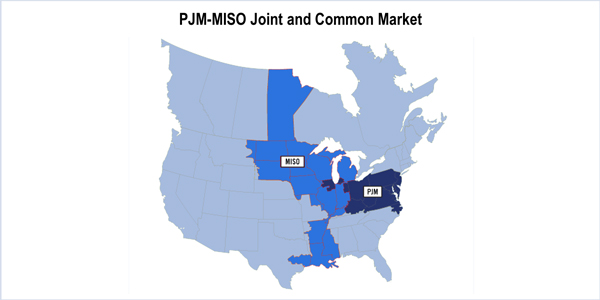By Amanda Durish Cook
MISO and PJM have responded to a FERC deficiency letter with a defense and clarification of their proposal to impose stricter rules on pseudo-ties.
In early August, the two RTOs filed identical proposals to permit them to terminate or suspend pseudo-ties that don’t acquire transmission service or follow modeling rules by providing real-time data. The proposals would also allow a balancing authority the ability to redirect pseudo-tie output to avoid exceeding NERC operating limits.
In late September, FERC sent a deficiency letter asking how a native reliability coordinator would commit, de-commit or redispatch pseudo-tied generation to avoid operating limits. The commission also asked the RTOs to clarify rules for suspending terminating pseudo-ties. (See 2nd Deficiency Notice Issued for MISO-PJM Pseudo-Tie Effort.)
In filings Oct. 30, the RTOs defended their proposals, with PJM saying redispatch and recommitment of pseudo-tied generation is essential to maintaining operating limits during localized thermal issues, voltage issues or islanding situations (ER17-2218). MISO also said a redispatch option is crucial during planned transmission outages, forced transmission outages or during periods of heavy system transfers (ER17-2220). PJM added that there would be no limit to the number of times a pseudo-tied generator could be recommitted or redispatched. MISO said pseudo-tied resources would still be eligible to provide reactive supply and voltage control service, a point PJM did not address.
PJM said its 42-month notice to terminate a pseudo-tie is rooted in its three-year advance capacity auction and would give “planning engineers sufficient time to take into consideration the impact of the termination” and pointed out that it is “consistent with the notice requirement that a capacity market seller must give to PJM when it intends to deactivate a generator.”
MISO and PJM said they would only terminate a pseudo-tie under the circumstances described in their respective Tariffs and both would generally try to impose a suspension period first, during which the resource is decommitted or manually dispatched. PJM said termination conditions are “for the most part … tied to a situation in which a pseudo-tie is causing instability on the bulk power system or raising or causing reliability concerns.”
In identical language, MISO and PJM also said they would use a case-specific approach to termination, and would work with generators to address problems and avoid terminations, which they called a “last resort.”
The RTOs have said that they would suspend a pseudo-tie when they are “reasonably” found to pose a reliability risk or don’t follow the rules of their attaining balancing authority. PJM added that the RTOs “expect suspensions to be very exceptional events.”
MISO and PJM proposed that suspensions occur without FERC approval, and that a contested suspension remain in force pending a commission decision.
Meanwhile, MISO is still awaiting final word on its pro forma pseudo-tie agreement for PJM. The agreement was conditionally approved by FERC staff in August before the commission regained its quorum (ER17-1061). The proposal also was the subject of a deficiency notice in the spring. (See FERC Conditionally OKs MISO’s Pseudo-tie Pro Forma.)





